WE HAVE FINALLY ARRIVED
It is the end of March 2012 and after a couple of years of flitting backwards and forwards, we are finally in France for good. Well I can't really say for good unless I get run over by a truck tomorrow, but hopefully, for a reasonable length of time.
The journey was very easy, after a horrendous start. We left Reading an hour late, at 08:00, which was pretty good going considering that we were at least one week short of the time we needed to pack everything. The result was not just leaving Reading in the rush hour but, for some reason, leaving Reading in the mother of all clogged up rush hours. It took us nearly an hour to complete a journey that is usually fifteen minutes, so we were now close on two hours late and in danger of missing our channel tunnel train.
However, on the M25 we saw a sign saying that the M20 was closed between junctions 1 and 3. At first that completely depressed me, but as I thought it through, I realised that we didn't join the M20 right at the top. Sure enough, we slipped onto the M20 at junction 3 and found no traffic coming from the north, so it was a lot clearer than usual. A quick dash at the soon to be legal 80mph and we made the train. Of course, one of the many plus points of the tunnel is that it would not have mattered if we had missed the train as the next one is only half an hour later; but I hate to be late.
Even as atheists, we realised, that some sort of god must be on our side, so we decided that it was Offler, the crocodile god from Terry Pratchett's Discworld. Offler was now the god of everyone trying to move to France, which meant that anyone trying to stop us from that point on would face the wrath of Offler, which came in handy in Rouen, where we stayed the night. For some unknown reason Rouen always seems to trap us into going the wrong way and, on one famous occasion, into going round in huge circles. This time we invoked Offler and were released from the clutches of the town immediately. By the time that Rouen realised we were gone, we were too far south for it to gather us back into its baleful embrace.
We arrived at Montgomard in the early afternoon and entered the house with some trepidation as It had been left without heating during the worst winter ever known in the area. It smelled a bit cold and damp, but nowhere near as bad as when we first moved into it. I was beginning to feel almost cheerful, but reality soon crashed in. The bed was not full of mould, which we had been expecting, but it was full of acorns and mouse droppings. Oh look the wildlife has been kind enough to welcome us with some food, oh and some pee and shit.
Now those of us of the male persuasion probably had beds when we were single that would have been hygienically improved by the addition of mouse droppings, but there was no way that Cami was going to sleep on that mattress, no matter how much it was cleaned. Fortunately, for complicated reasons, there were two mattresses on the bed, so the pillows, duvet and one mattress were consigned to the rubbish and we drove into Bellac to buy some new bedding and order up a mattress, only to find Offler looking after us again. "Delivery on a mattress?" Apparently that could be a problem as the salesman's colleague was on holiday. "How about this evening, sometime before eight"? I thought Cami was going to drag him to the floor and make love to him there and then.
The other small problem was that we had no hot water. Winter temperatures had dropped to -21C and Yvette and Gerard next door were without water for a week and a half when their pipes froze inside a wall. I had drained our system completely before we left last October to avoid such problems, or I thought I had. I must have missed the hot tap in the bathroom, which is fed from the hot water tank via the currently un-insulated loft. We phoned M Le Comte, who is installing our central heating and he sent Sebastian, one of his sons, to sort it out. Sebastian was not best pleased to be pulled off a well-paying job in Limoges just because his dad was a bit soft on Camiila, who had lent him a pain killing machine last year. He fixed the leaks, all six of them, but one of them has sprung again. A tiny leak; which I have temporarily fixed with some self-sealing tape. Bingo, hot water.
Just to make our welcome complete, the weather is still bloody cold. It is now the middle of April and the temperature is due to drop to freezing tonight and us with still only our two trusty gas heaters. This time last year, we were in the middle of a heat wave. You can't trust anything nowadays, not even global warming.
STAIRWAYS AND LADDERS
I have started knocking out the new entrance to the ground floor bathroom.
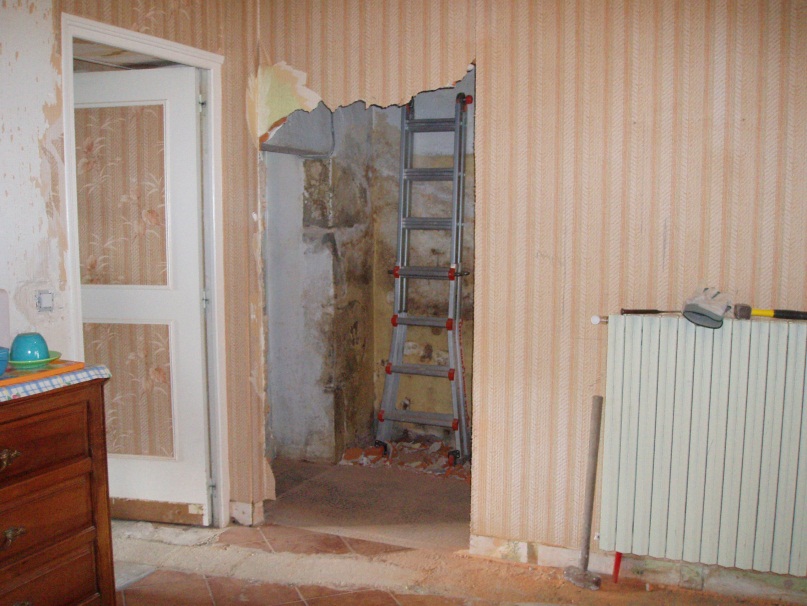
This will enable us to stagger out of the bedroom door, which is in the left of the picture and turn straight round into the bathroom, rather than having to cross the living room and then approach via a long dark corridor, which will become a stairwell for the new inside staircase.
A quick rip with the construction saw, then ten minutes with a sledge hammer and look, another hole in the wall. Needless to say, the wall is not load-bearing.
Of course, you could argue that moving the staircase inside spoils the early nineteenth century character of the place, but the first floor was never part of the living space, simply a grain store and mouse hotel. We firmly believe that the early nineteenth century character is best preserved by turning it into a bright and lively part of our home rather than leaving it as a derelict reminder of times past.
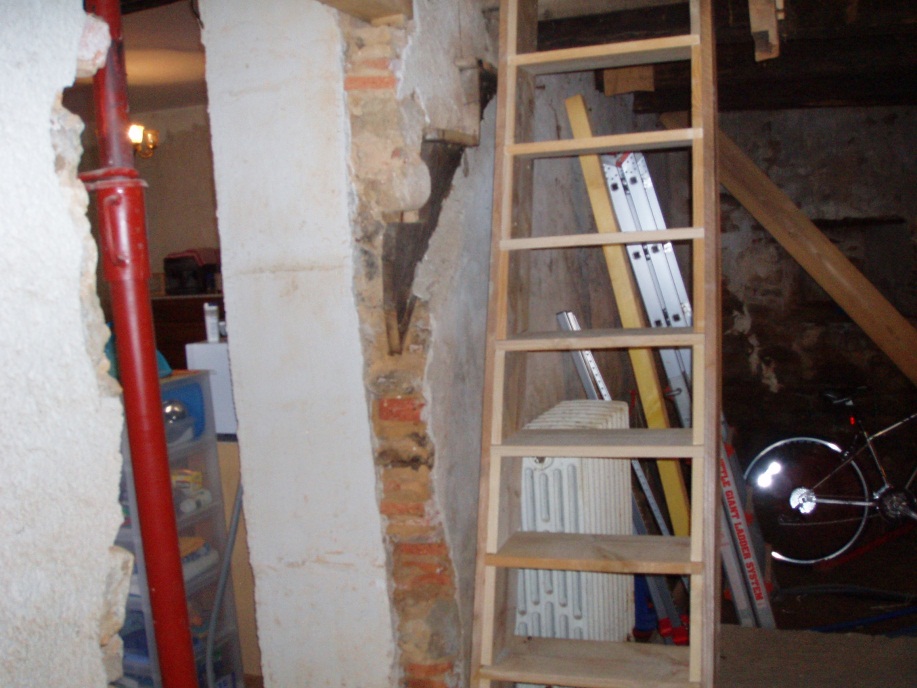
Once all our gear had arrived in a van from England, I soon became fed up with trying to struggle heavy cartons up a builders ladder for storage in the attic above the back kitchen. I tried to buy what is called a Miller's ladder, which is a simple open tread staircase set at the angle of a ladder, so that it doesn't take up much floor area. I don't know why millers are parsimonious with their floor space, but the commercially available ladders were all much too wide for the space available, so I made my own.
The 200mm deep treads make it much easier to balance whilst carrying heavy loads and mean that we can use that attic as a storage area in the knowledge that we can easily get things out of it should we need to. However, I have set it at a fairly extreme angle for a ladder to clear the doorway, some 20°, whereas a ladder would naturally sit at some 25°. Clearly, I am more parsimonious with floor space than the average miller, but I did also need to clear the radiator that you can see behind it.
To the left of the ladder, you can see part of the riser for the original staircase, which came down right across what is now the entrance to the living room.
To the right of the ladder, you can see the rear wheel of my urban warrior, all terrain bike. Claude Butler frame, twenty Shimano gears and a hydraulically damped saddle. I bought it about three years ago, rode it round the block a couple of times and decided that English car drivers were too homicidal to use it in anger. In France of course, cycling is a religion and every Sunday the roads are packed with hordes of determined pedal pushers, all wearing bright jerseys plastered with advertising. During the week, we quite often see two or three old coves chatting away as they slowly meander along and, as is the unalienable right of French cyclists, they never ride in single file if they can ride two or three abreast. So I figure that I might be able to get to the bread shop and back without being run off the road into the nearest ditch. We shall see.
I CAN'T STAND THE RAIN
It is the third week in April and the continuous rain is really putting a damper on my renovation efforts. Most of what I want to do involves cement, concrete, that funny white sticky stuff that building blocks are held together with, or lime plaster. In every case it involves the cleaning of tools and containers afterwards.
Things like trowels and floats can be cleaned in a bucket in the work area. The cement mixer can also be hosed out on site and the resulting slurry turned out into a wheelbarrow, but buckets and wheelbarrows, used to transport the sloppy stuff have to be moved some sixty metres in the pouring rain and hosed out in a special "dirty area" outside the barn. I know it sounds daft having a special area, when the whole place is dirty, but it will make it much easier to clear away if all the noxious waste is kept in one place. It is surprising how many excuses you can find to put off a job at the thought of that later walk in the rain.
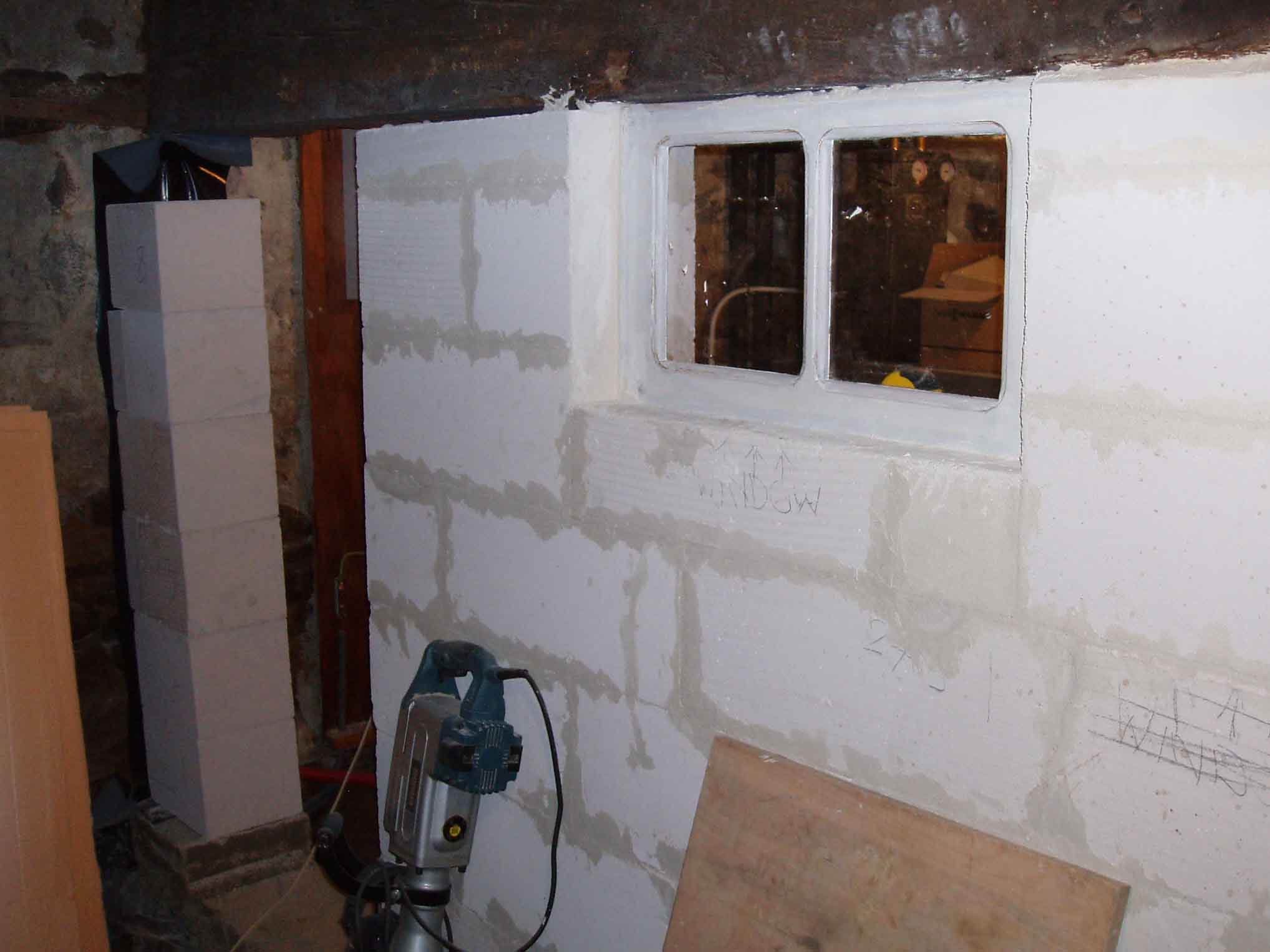
However, I have managed to raise my first wall. This divides the back kitchen, or scullery if you prefer, from the boiler room or, as we like to call it, the cave. That's the French cellar, not a hole in the ground. In a couple of years' time, the cave will be filled with preserved fruit, jams, hams, favourite wines, the odd cheese that isn't allowed in the house and, of course, Titanic, the boiler. If you think that the pillar on the back wall looks at an odd angle, that's because it is. At the moment it is just a pile of blocks resting on the foundation, but it will have iron bars going through the centres to tie it together vertically and steel plates to lock it to the back wall. At which point it will hopefully be perpendicular.
Whilst building the wall, I have fallen in love with Beton Cellulaire. Beton cellulaire is the aerated concrete that the wall blocks are made of. It is reasonably light to handle and the blocks are held in place with cement based glue that gives a very thin joint (5mm maximum). After struggling with English bricks and thick cement joints, these things are a breeze; but not a breeze block, which is a very heavy English building block that does the same job but at the cost of a lot more effort.
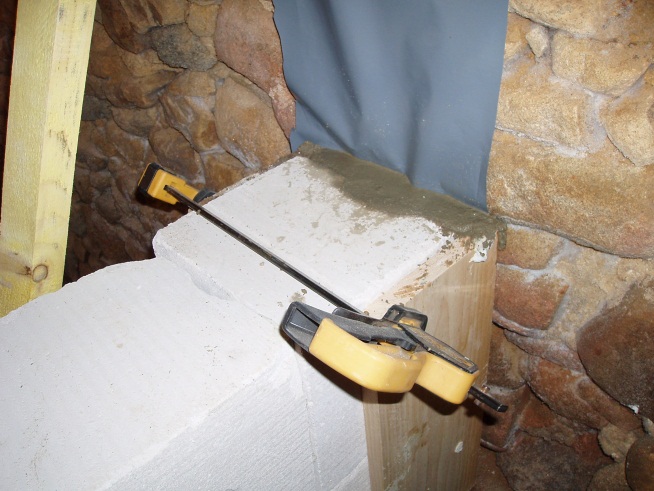
It is like working with giant Lego bricks, with only the locating pins missing. I guess they have to leave something for the artisan to do. Anyway, walls go up very quickly and it is very easy to keep them straight and perpendicular. Which left me with one technical question,
how do I join a straight perpendicular wall to a wavy granite wall? The two walls don't have to key, but a thermal barrier is necessary between one side of the block and the other. Here is my solution.
I laid a band of the same polythene that I am using under the concrete floor against the wall and then filled the gap between the blocks and the wall with cement. The cement pushes the polythene into the general shape of the granite wall and a couple of clamped formers hold it in place at the sides. As each course of blocks is laid, I move the formers up and pour in more cement. There isn't much moisture on that wall as there is a covered pig pen the other side, but the polythene ensures that the porous blocks are protected from anything that might seep through.
Needless to say the success of such an easy building system is in the foundations and I am glad I spent so much time getting the foundations straight and level. If you have a level platform to start with then even a novice like me can put up a wall in no time flat.
Beton Cellulaire also has excellent thermal insulation properties, with a U value of 0.34 for the 250mm thickness and, if you ask me very nicely, I will explain to you sometime how those funny U values work. In the meantime, I am certain that we can provide a good thermal barrier between the back kitchen and the undeveloped cave.
Apparently it is going to stop raining at the end of this week, but I am not yet convinced.
The very last day in April and a violent storm is raging. It really hasn't stopped raining for over three weeks and I fully expect the water table to rise through the floor sometime soon.
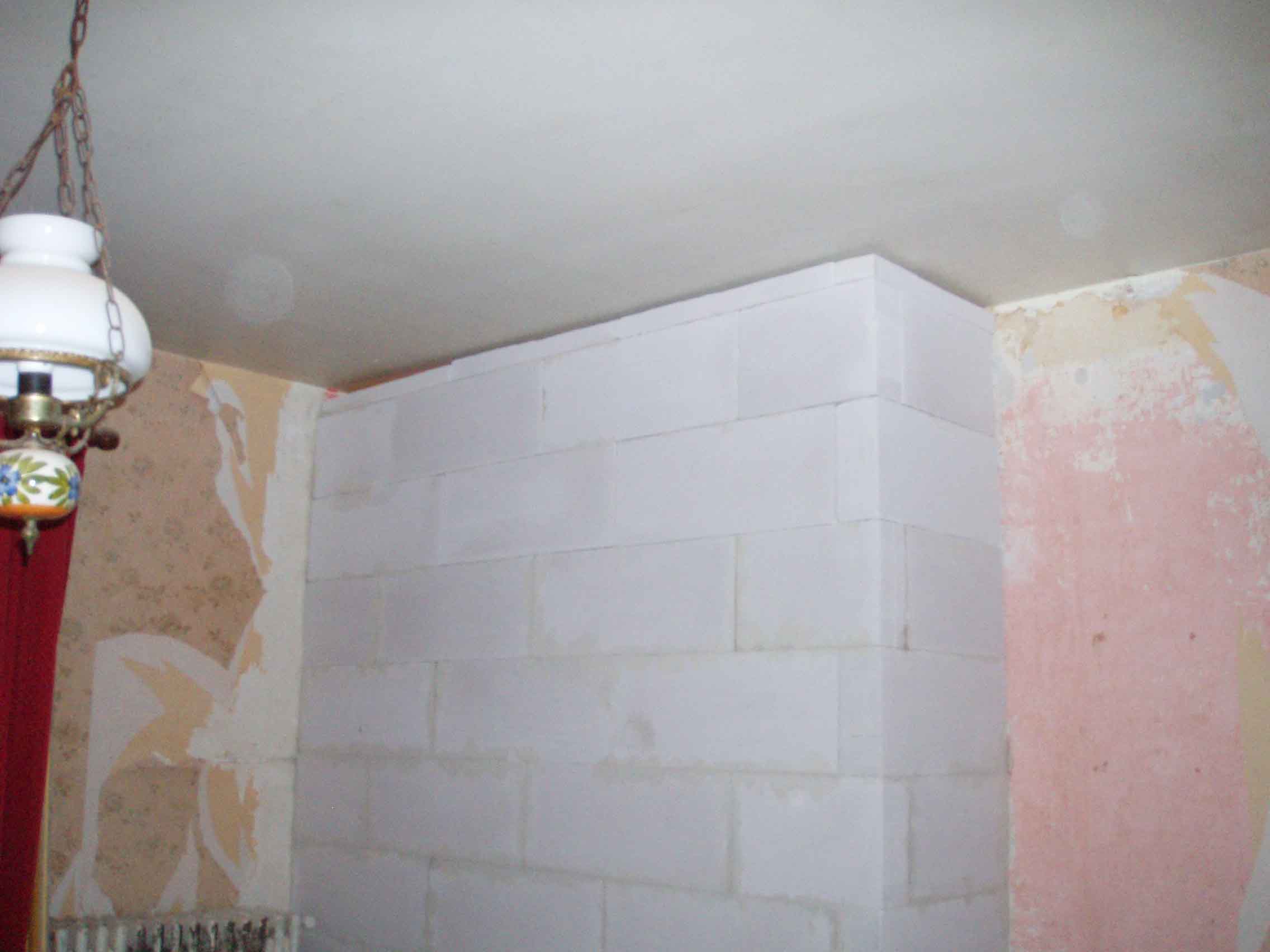
Fast forward to the nineteenth day of May; the rain is now more intermittent, but still ever present. Everybody's tomato plants are galloping away in their pots, but cannot yet be planted out as there is still a risk of frost. I however, have raised my second wall and it is a great feeling to be building at last, rather than just knocking things down. This wall increases the space in the bathroom but, more importantly for this years' priority, gives us somewhere to hang the heated towel rail, which is the last piece in the central heating network.
This view is from the bedroom side and the 100mm blocks that I used are really self-supporting, but the wall is also tied to the two existing walls with steel plates every other course. Call it belt and braces.
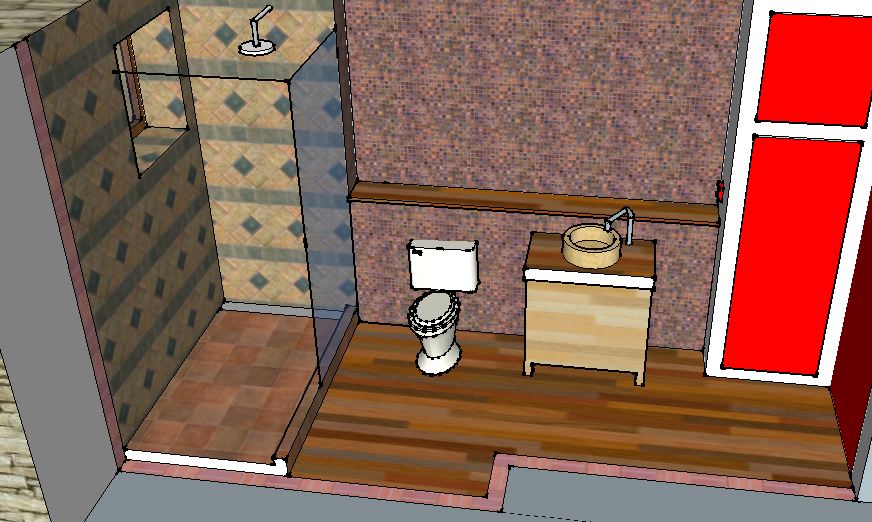
This is a rough idea of what the bathroom behind the wall will look like. The extra space will allow for a two person walk in shower and will stop the room looking like the corridor it really is.
A STARTER FOR CHEESE
Without French cheese, my life would be much poorer; without any cheese, my life would be intolerable. For me, any meal that does not end on cheese is just a snack. Many times I have munched impatiently through lobster Newburg or Chateaubriand only to be disappointed when we get to the cheese course by some pale imitation cow substance that is made from pasteurised milk.
Cheese is a perfect example of how humans are really nothing more than a sack for bacteria to live in. Without bacteria, real cheese cannot be made and without bacteria, humans cannot survive. In any one human, there are between ten and a hundred times as many bacteria cells in and around them than human cells, but they only make up about 200 grams in body weight.
It is interesting that up until a few thousand years ago most humans, like other mammals, were lactose intolerant once weaned; they could not digest milk. How do we know that? Genetic analysis of course! A good book on genetic archaeology is "Genes, People and Languages" by Luigi Luca Cavalli-Sforza. What humans could usually digest was milk that had been turned into cheese, as traditional cheese making techniques drastically reduce the lactose content. What we are saying is that something fresh and wholesome (milk) was being rejected by the human body, but something rotten and decaying (cheese) was happily accepted. Tells you something, doesn't it.
In between writing these sentences, I am carefully spreading creamy ripe Roquefort onto bread and washing it down with a reasonably priced 2010 Bordeaux. The wine is fresh and fruity, but the cheese tastes as though it has aged gracefully for at least a thousand years. With each swallow I am introducing a few billion new bacteria into my sack to jostle for room with the trillions that are already living in it. Am I worried by eating germs? Am I hell! If the bacteria in my body don't get introduced to some new companions on a regular basis, they get lazy and when I really need them to fight off some nasty foreign bacteria, they will be underweight and unable to throw a good punch.
Next time you squirt your "Kills 99% of all germs" cleanser, remember that some of those germs may be all that stand between you and a serious infection.
Of course all of that will not stop the argument as to which is the best cheese, but I do not intend to get involved in that argument. Suffice it to say that the milk; be it from cow, goat, buffalo or deer, must be unpasteurised to avoid killing off the bacteria. Apart from that, make what you will and I will eat it.
There is an old saying about wine; that you should buy on apples and sell on cheese. Apples bring out the raw tannin taste of wine whilst suppressing the fruitier flavours and cheese does the opposite. What brings out the flavour of a strong blue cheese such as Roquefort is a perfectly ripe pear. I know that because I am eating one. This must be one of the last of last years' stored fruit and it is so on the edge that the flesh is tinged with brown after being exposed to the air for just a few moments. But the taste! The taste is like the essence of fruit. Put bread, cheese and pear in your mouth and just drift away down the Nile with Cleopatra.
I must lay some concrete tomorrow; otherwise people will think that I have got so philosophical about food that I am turning into a Frenchman. C'est vrai.
MONTGOMARD GOES DIGITAL
It is the middle of April and I am sitting looking at something called a Livebox, which arrived in the post this morning, along with a letter from Orange Telecom confirming our subscription for telephone, broadband and TV services. Nothing worth writing about there you might think, but until the postman knocked on the door we had given up all hope of the box ever arriving, or our broadband connection ever being enabled.
This particular saga started a month ago, the day after we arrived in Montgomard, when we received notification from Orange that they were coming to install our system, but to let them know if the Livebox didn't turn up. Now, Orange is the trading name for Telecom France, which is half owned by the state and half privately owned. I have nothing against state owned companies and I think that countries that have kept national control of strategic industries are going to be looking pretty smart in a few years' time. No, the problem is simply the size of an organisation; whether it is publically or privately owned is immaterial.
Orange is huge and can only be understood by the humans that purport to control it if it is completely compartmentalised. What is meant to meld all the bunkers of separate activity together into the slick, customer facing, forward looking…….(insert your own list of management speak inanity here)….organisation that exists in the four martini mind of the chief executive, is the multi-million dollar computer system, usually provided by either SAP or Oracle; with someone like IBM having helped with the implementation.
So, Cami starts talking to Orange staff on the telephone, who are unfailingly polite and helpful, to try to sort out the problem of us not having received a Livebox. They look up our details up on their system, the multi-million dollar one we mentioned in the last paragraph. They show the Livebox as having been delivered, but will cancel the installation appointment whilst it gets sorted out. What is important to understand at this point is that we are dealing with two different bunkers, one which handles installation appointments and one which is looking after subscriptions and, by implication, Livebox delivery and the reason that installation engineers do not carry Liveboxes with them is because that is not how the multi-million dollar computer system was configured.
As far as we could tell, the installation bunker had cancelled an appointment, how wrong we were. We go to the post office and they show the parcel as having been delivered but, because it didn't require a signature, they have no further details. That multi-million dollar computer system I might have mentioned earlier despatches expensive electronic equipment without any way of ensuring that it will be delivered correctly.
Cami talks to the subscription bunker of Orange again. No problem, they will send us another box, which might take 72 hours to arrive (it finally takes two weeks) and they make another appointment for the installation bunker, again telling us to let them know if the Livebox doesn't turn up in time. Guess what, it doesn't turn up. What does turn up is a letter saying that as we have cancelled our contract, can they have their Livebox back. Oh, and a statement showing that they have taken the installation fee and one months' subscription out of our bank account.
Back on the phone to the subscription bunker: Which can only be done at 08:00; after that the lines are too busy to get any response before the credit on our Orange pay as you go phone runs out. Yes, the system shows that we have cancelled our subscription, but no problem, they will restore it. We say thanks, but let's not try to set up another installation appointment until the box really arrives, and by the way do not enter any form of cancel into your system; we are deferring installation, in no way are we cancelling anything. No problem.
You can probably see what is happening by now. Both bunkers are looking at the same multi-million dollar system, but are seeing different things. Cancellation of an installation in one bunker is being seen as cancellation of a subscription in another and there are no checks to ring alarm bells in the sales bunker on termination of subscription. I have been here so many times before when trying to get people to understand that their shiny new multi-million dollar system has been badly specified that it gets boring. Every bunker specifies what they want, which is based on what they have always done. During implementation, cross-bunker meetings are regularly held and regularly avoid making any logical links between bunkers. The system goes live and everything is fine, until something unexpected like a lost Livebox happens. Now bunker mentality kicks in and everyone, in a friendly and helpful manner, responds to their limited view of the system in the limited way that they have been trained for.
Eventually, after many telephone calls by Cami, it has been agreed that next Monday an Orange engineer is going to install everything and we have a brand new subscription agreement to sign. I am not sure that we are really any nearer success. You see, I have installed a telephone on the line, using the strange connections that came with the Livebox, but have no dial tone. I cannot believe that the Livebox does anything more that validate the subscription before connection, so either Charles, our electrician, has wired the telephone line up wrongly to the wall socket via the comms box, which is very unlikely, or we don't have a live telephone line. Unfortunately, testing is no longer as simple as detecting a voltage, as with an ungrouped ADSL line there is no residual voltage on the line and I don't have a signal tester. Why don't I have a signal tester? Well, up until now, I have always used fibre optic cable for broadband, so I have never felt the need to test an ADSL line, silly me.
Monday has come and gone and we still have no internet connection. How unexpected. Apparently the line is dead , so on Wednesday, a Telecom France engineer (they are the wholesale arm of Orange) is going to come to run a new cable. Look how patiently I am waiting.
To be fair we are slightly closer to connecting with the world; Windows tells us that we can now get as far as the magic Orange Livebox.

What did appear this morning was the original Livebox, which had taken a pleasant trip to England and back. This tells us two things about how rural services work in France. Firstly, our redirection of French mail stopped on the 29th of March and the parcel arrived in the local post office on the 30th. The decision to redirect to England was taken, not on something as cold and bureaucratic as a date, but on the fact that the postie hadn't seen us around, so thought we were still in England. Secondly. the local post office was quite happy to redirect a reasonably large box, along with the letters and small packets that the contract specifies. It plays havoc with the bureaucratic telecom company system, but has a human dimension that is strangely attractive.
It is now Wednesday, 2nd May and we have an internet connection and a telephone. Praise be to Offler.

A very pleasant Telecom France engineer turned up this morning, found a fault on the connection from the pole on the other side of the farmyard, rushed off to Le Dorat to check something on the exchange, came back and fiddled with his signal tester a bit and declared that we had a fine network. He was also impressed by the comms stuff that we had specified; which was a nice complement from a professional.
Needless to say, he got the full coffee treatment from Cami. That's a choice of black or white, sugar or sweetener and a cake on the side.
The first thing I did, once I had shaken his hand, waved him off and prised Camilla away from a very long international call, was to download bank data and perform the first financial reconciliation that I have been able to do for a month. Needless to say, everything was as expected and our projected cash flow is right on course. It couldn't really be otherwise, as our finances are very simple, but I get very twitchy if I can't confirm that on a weekly basis.
WE FINALLY MAKE FIRE
In mid-September, autumn was drawing on, although the days were still very warm and we had heard nothing from our central heating engineer about making the final connections on the central heating system. I was getting worried that we would be facing a mega ice storm with nothing more than our two trusty bottled gas fires. Cami was set to work leaving endless messages on Mr Le Compte's answer phone whilst I tackled the fireplace so that we could at least install the backup wood-burning stove.
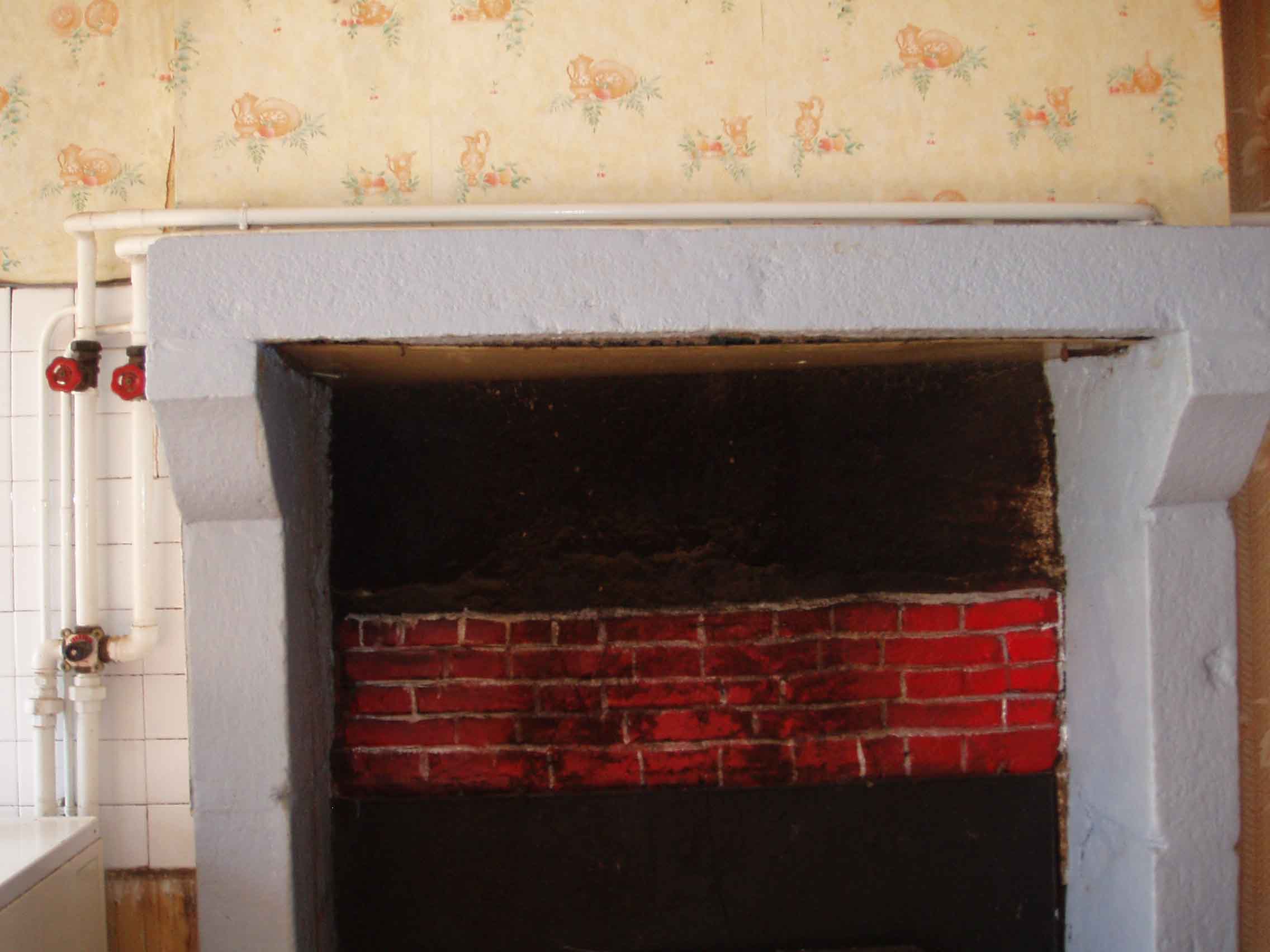
The fireplace was a complete mess. The stone surround was painted in blue gloss paint. Some of the bricks at the back had been picked out in red and the rest were covered in black tarry gunge. Clearly, something drastic was needed to unify the whole area and provide a suitable background for a wood burner.
The first job was to clean off the blue paint which took many hours of effort with both noxious chemicals and a hot air gun. I splashed chemicals at it, which did lift some of it off, but Cami tackled most of the hot air work.
We then opened up the chimney, which involved prising off a sheet of hardboard supported on six inch nails. This released a shower of ancient soot, dead birds and spider cocoons. Clearly we were going to need the chimney cleaned. There would be a chimney liner going in, but a hot liner and an assortment of combustible materials is not a good combination.
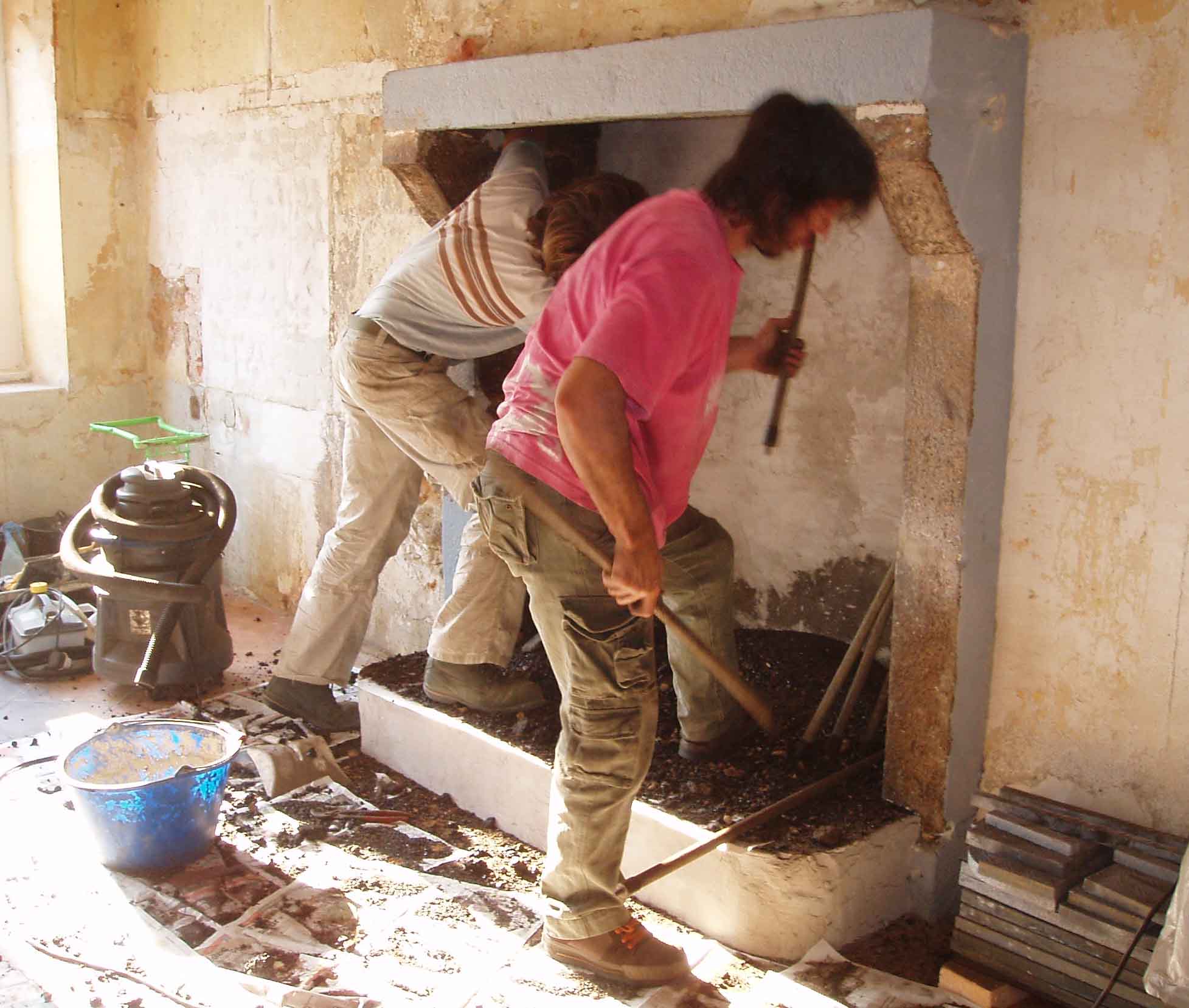
But first I skim coated the bricks at the back and raised the floor level of the fireplace to put the stove at the right height for old and aching backs.
Here are the chimney sweeps pulling about one hundred and fifty years of soot out. By the time they were finished, it was up to their knees.
The stonework of the surround was in poor shape so we decided to use a wall coating made of crushed shells. Cami had the best description; papier-mache made with shells rather than paper. It is a three part process. First a strong undercoat of sand and glue, then the shell coating and finally a sealant to make the whole thing washable.
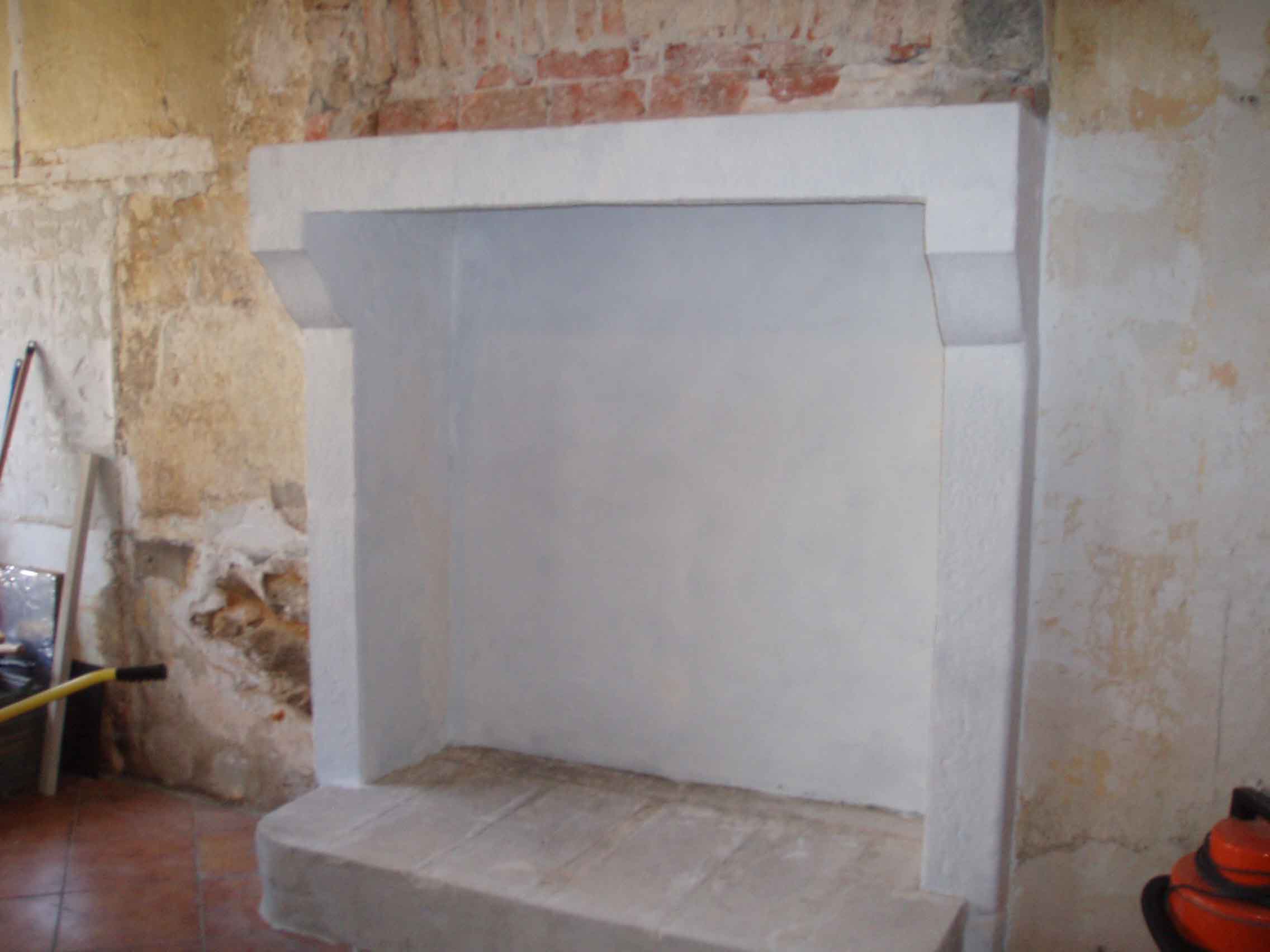
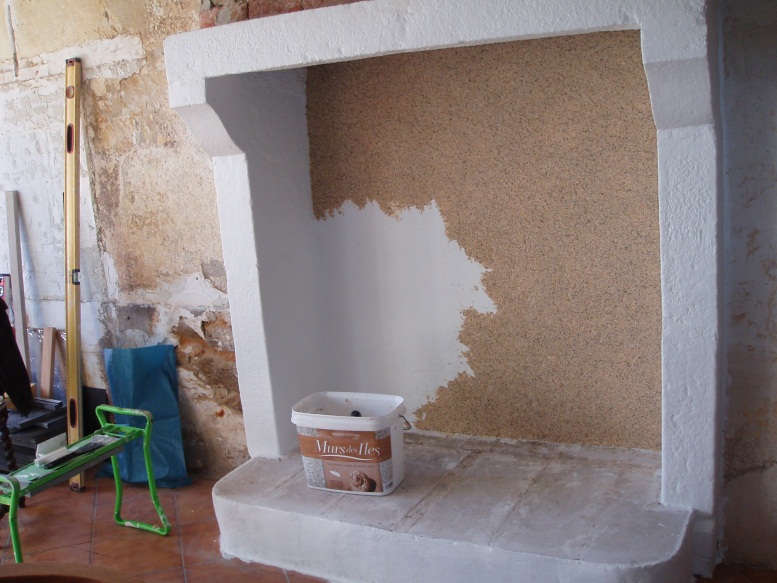
On the left, you can see the undercoat and on the right, the shell coat being applied. It is put on with a plastic trowel and you try to get an even coat of about 1 to 2 mm.
Finally, after many days of waiting for things to dry, the stove was installed.
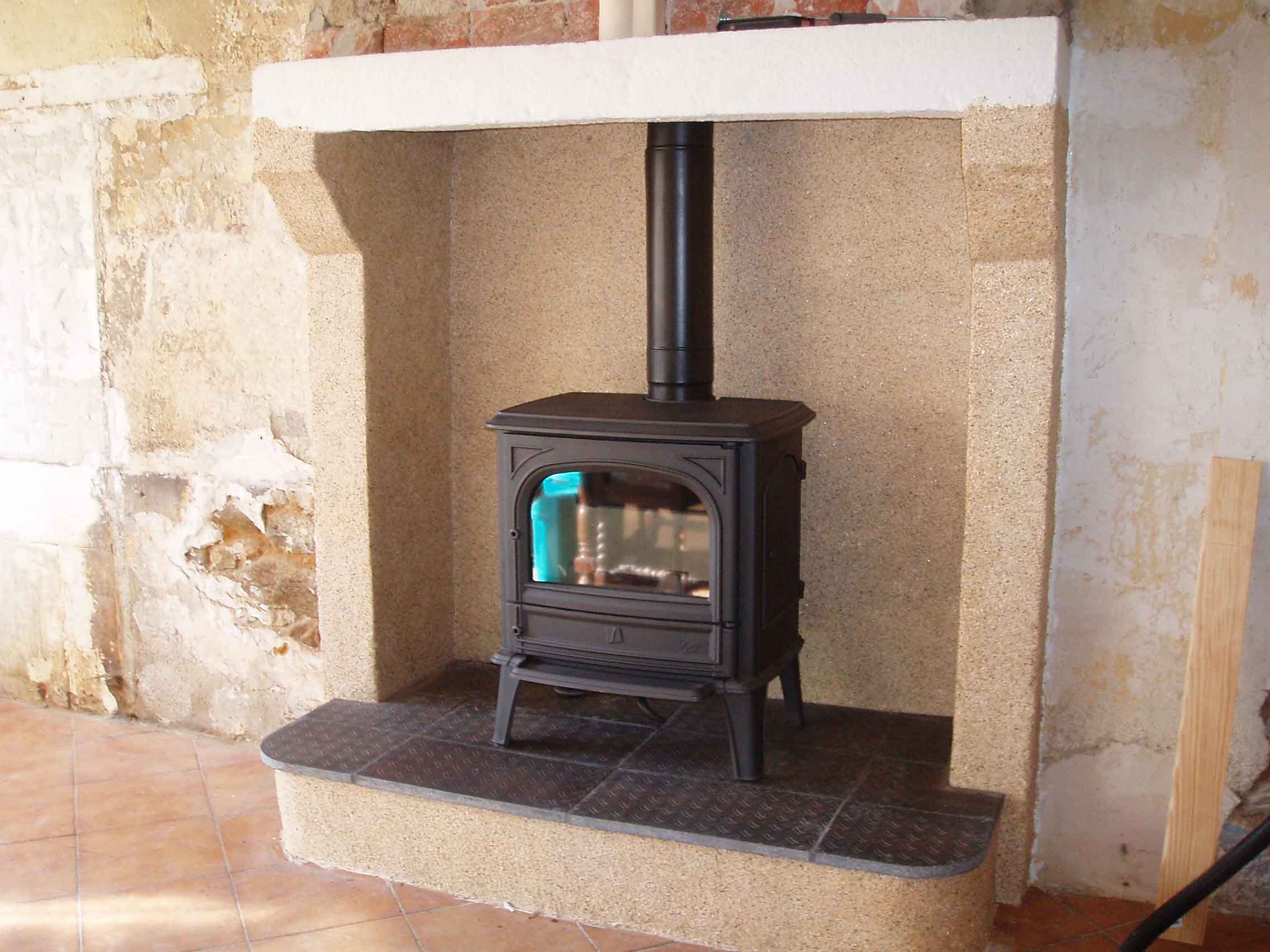
I was quite pleased with how the curves on the fireplace tiles came out. They were roughly shaped with an angle grinder and then smoothed with a little air grinder, fitted with a polishing stone.
You might notice that the mantle looks unfinished. That will be an engineered beam of either Oak or chestnut.
We started off looking at Godin and Invicta stoves, very frilly with brass detailing, but Serge, the local stove salesman, sneered at such stupidity. He explained that the large companies got their stoves from China and that the cast iron was of very poor quality. Instead, he persuaded us to go for a local French stove. His ace argument was lifting the top off and pointing, "Look at that". All we could see was more cast iron but, rather than look more stupid than he already knew us to be, we nodded in agreement. So we ended up with a rather plain stove that we now think matches the space better than the frilly ones.
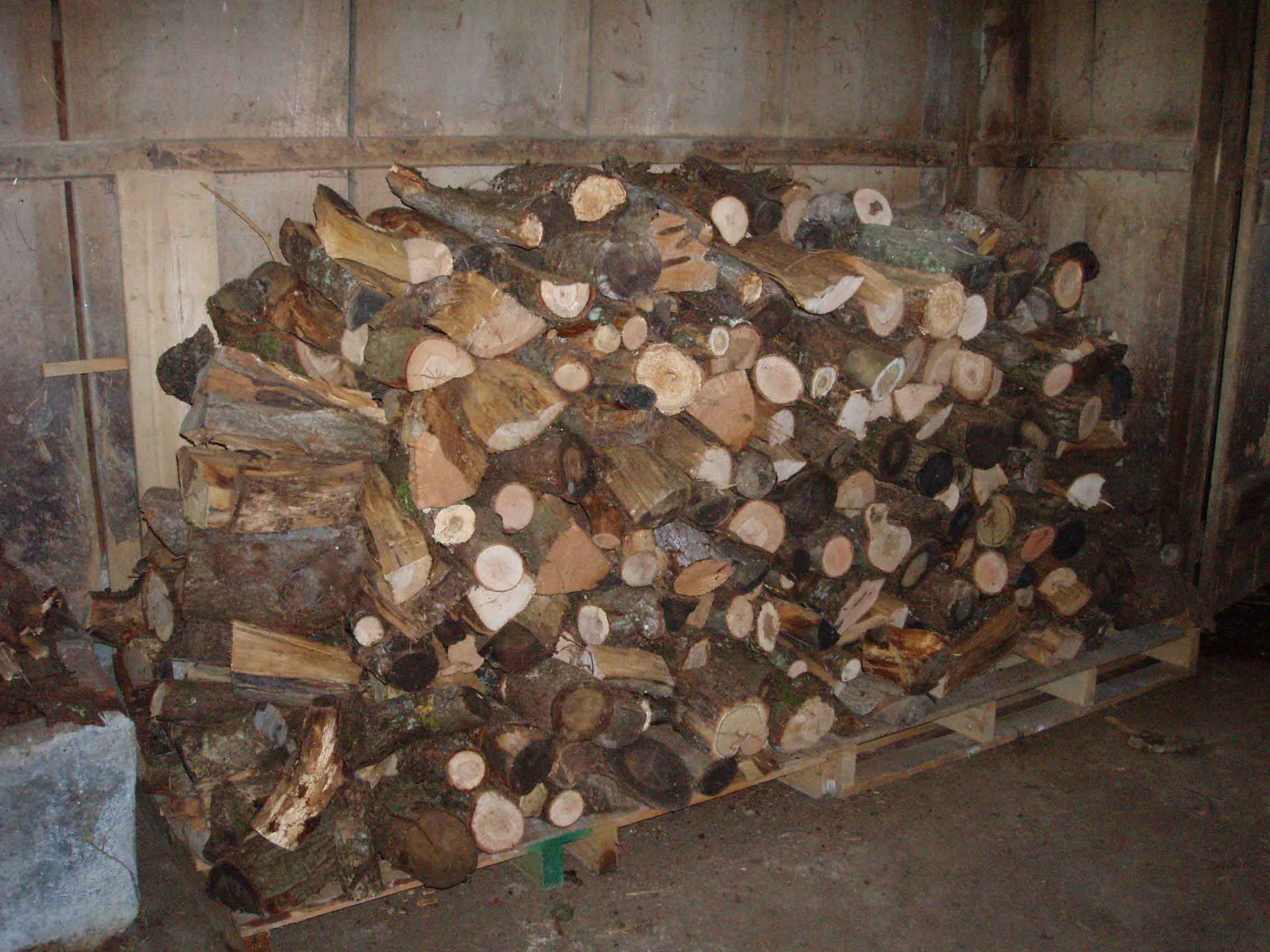
We took delivery of our first load of firewood today, which we bought off Jean-Marie. Firewood is measured in another of those wonderful old sets of units, steres and cords. One of the tractors trundled round with a cord, that's three steres and that's about three cubic metres. I looked up the U.K. price for seasoned oak logs and it averaged around £150 per stere. We are paying €140 for three steres, that's about £112 at the current exchange rate. How good it is to live in a land of forests.
Here is part of our hoard, stacked in the barn. It is raised off the floor on some pallets and is held away from the walls with support sticks.
By the way, I said that a stere was a cubic metre, but that is only strictly true if the logs are each a metre long. Cut them in half and you end up with slightly less than three quarters of a cubic metre. Cut them in half again and you end up with something over one half of a cubic metre. The shorter the logs, the less bends there are, so they pack tighter together. It is important to know such things if you are to avoid making a fool of yourself complaining that you haven't got the stere you paid for.
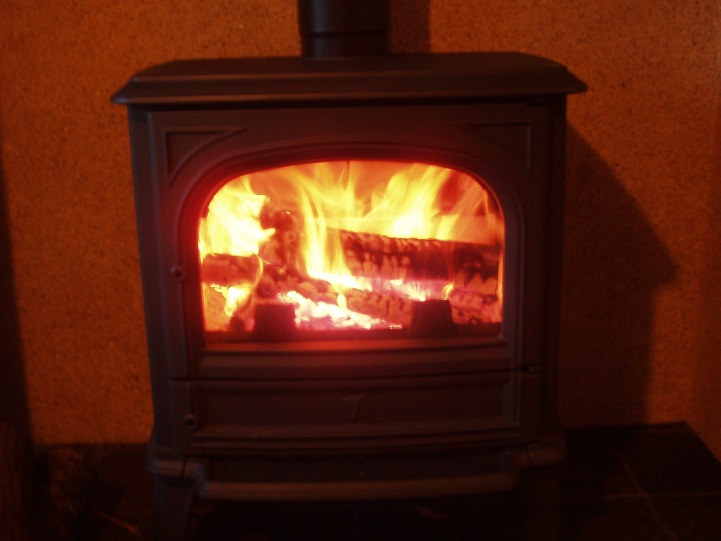
It is the beginning of December and the central heating has been up and running for a month now. Mr LeCompte finally turned up and connected everything. However, it is still nice to see the glow of a real fire.
A NEW DOGS LIFE AND DEATH
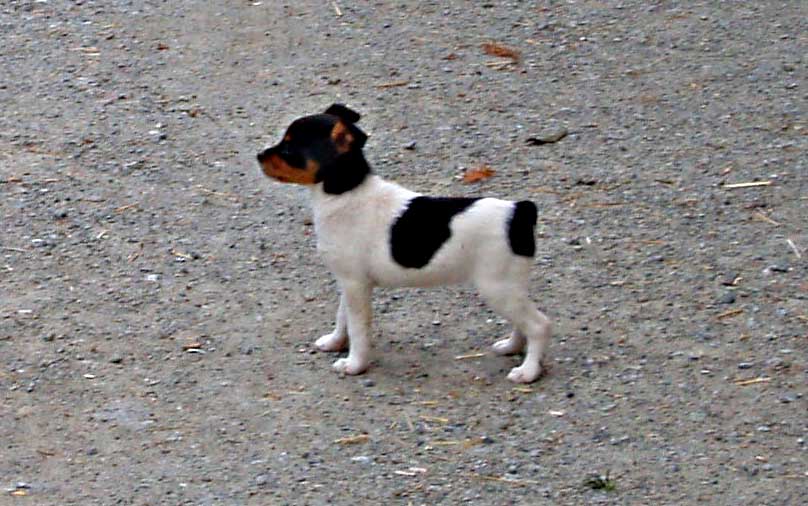
In early March, there was a new dog on the block. A tiny little bundle of energy that Yvette and Gerard acquired to replace Pollux. It was some sort of terrier cross, so would make a good ratter, always a smart addition to a farm. It was called Houpette, as this year is an H year for animal naming in the Limousin and those of you knowledgeable about French word forms will also know that it was female.
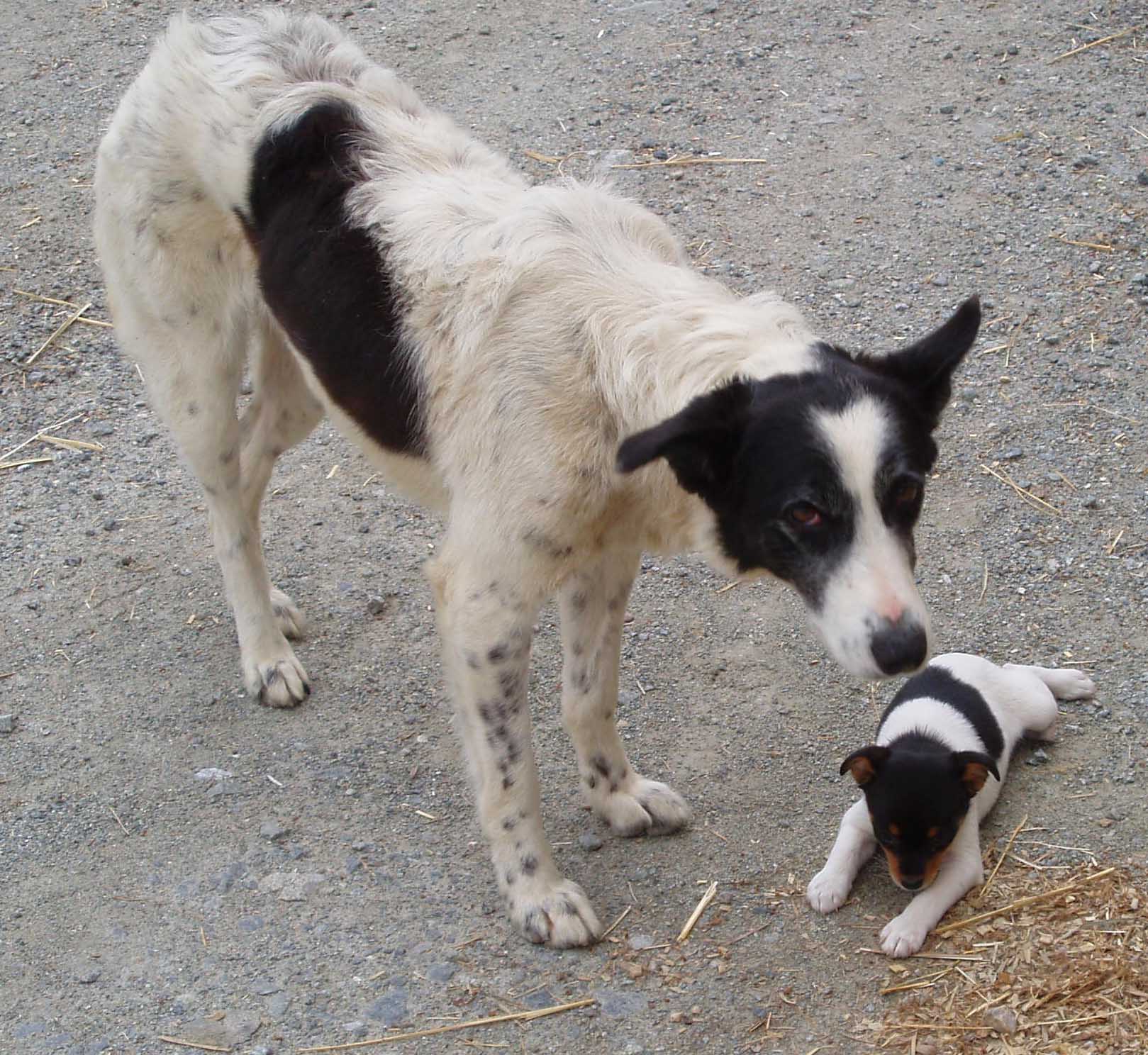
Dolly is quite curious, but you can see from her expression that she already knows that no good will come of it.
I speak in the past tense, because it is now mid-December and the little mite has just been killed. One minute she was helping me to sort branches that had been lopped off a tree and the next she was clipped by a car in the yard and killed outright. Nobody but me blamed the doddery old fool who was driving, but he clearly wasn't used to having dogs around the car. He braked when Dolly ran in front of him and then accelerated again. The sudden changes in speed caught Houpette out and she was struck by one of the rear wheels.
Whenever you have dogs around, particularly if they are chasing your car, keep a steady speed. It doesn't matter how fast or slow you are going, just keep to that speed and the dogs will work out how to avoid you.
I will miss her madcap antics.
DUMBER AND DUMBER
I am much less intelligent than I was thirty years ago. In 1982 I could have told you exactly how particle physics worked and why agriculture was such a great leap forward for mankind. I no longer know those things and it is unlikely that I will have any real sense of certainty about understanding anything ever again.
The received wisdom is that as you grow older, so you get wiser and more experienced. I have certainly got more experience and for physical tasks, that easily translates into wisdom. I can use most tools with perfect fluency today and in a manner which is much safer than my previous methods. So I am wiser in the physical things that I do, but not, I submit, in the things that I think about, and that is what intelligence is supposed to be for.
Before I describe how I lost my intelligence, It is necessary to understand what intelligence is, and to answer that, I have to pass the question to you. You see, intelligence is whatever you want it to be. Take two people, an M.I.T. professor and an African Bushman , place them both in the town of Cambridge, Massachusetts and test their intelligence. It's a wild guess but let's say, for the sake of argument, the M.I.T. professor tests as more intelligent. Now drop them both into the middle of the Kalahari desert and see who comes out alive. After some more wild guesses, does that now make the Bushman more intelligent? He recognises hundreds of tree species, whereas the M.I.T. professor may recognise a dozen. Does that make the Bushman more intelligent? Is intelligence absolute or relative and, if it is absolute, what are we measuring it against?
An equally difficult question, which has plagued research for decades, is whether intelligence is innate, which means it is genetically based, or acquired, which means that it is formed by environment. There is clearly a genetic component to intelligence. How do I know that? Simply because intelligence depends upon brain functions and we know that they are genetically determined, but it now appears as though intelligence involves so many different genes that we may never know how they all contribute to the whole. What we do know is that it doesn't really matter, because, in the short timescale of one lifetime, environmental factors swamp any effect that genes might have. Studies of identical twins brought up in different environments have shown clearly how environment affects the most popular measures of intelligence. However, the effect of environment is by no means simple. A loving home in a poor area and a sterile home in a rich area, will both influence intelligence, but not necessarily in consistent ways.
Intelligence is also in some way linked to physical senses but, for example, there are some blind people, measured as more intelligent than some sighted people. Of course, we cannot avoid the matter of intelligence and race. This one is easy. Show me what a race is and I will then try to tell you whether there is any difference in intelligence. By any reasonable definition of race, there are somewhere between five and one million races on earth. Just think of the different skin colours, eye shapes and body styles contained within "Asian". We are, like it or lump it, all human. Although we are not all Homo Sapiens as it turns out that most Europeans have some 10% Neanderthal genes.
So, decide for yourself what intelligence is and we can continue.
For me; it is something to do with knowing and/or understanding, which neatly gets me back to the things I no longer know or understand of which I will give you a couple of examples. When I was much younger, the material world, whilst not exactly simple, was at least understandable. There was a biological level, which was based on a chemical level, which was based on a physical level. At the physical level, there were atoms, which were made up of quarks and leptons.
Now, at every level and particularly at the physical level, this description is a gross simplification, but it is only a simplification of example, not of concept. In between quarks and atoms, there are hadrons, like protons and neutrons, which make up atomic nuclei and we haven't mentioned the six favours of quark; up, down, bottom, top, strange and charm, nor the six flavours of lepton; electron, electron neutrino, muon, muon neutrino, tau and tau neutrino. Nor have we mentioned all the anti-particles, which usually only differ in charge from their particle counterparts.
O.K., so it's not so simple as I remember it. But it still is contained within the idea of little bits coming together to make bigger bits and this idea is vital. If a particle is part of a bigger bit, it can't also be part of a different bigger bit. The other vital idea is that the smallest particle must be a point; mathematically it has no dimensions.
In the year 2012, neither of these ideas is any longer true.
The latest theories posit that the smallest particle might not be a point, It might have one dimension, making it a string and that the endpoint of such a string maybe a brane (taken from membrane) which can interact with other branes to form higher level structures. The logical conclusion of such a state, well logical if you are a particle physicist, is that there are other dimensions to the four we know and therefore a multiplicity of universes.
From this idea, it is also possible that a particle can be linked to another particle, separated in space and time, through an idea called quantum entanglement. Whatever happens to one particle, happens also to the other, via some brane or other. Now, all of a sudden, instant matter transport becomes a possibility, which should worry Eddie Stobart and time travel becomes a matter of routine, but please be careful not to run over your grandfather.
I don't pretend to understand any of this and, more importantly, I don't know whether it is based on the real world, or the floating thoughts of some physicists in need of a grant to continue their research. It is unlikely in my lifetime that any theory of the world of particle physics will be agreed and indeed, it could all get a lot more convoluted before an answer is arrived at, so I have to say that I no longer know how the physical world works.
The arguments about the great leap forward that the introduction of agriculture gave to human civilisation are more subtle and my thoughts on the subject are still somewhat confused, but what I now understand is that the simple progression that used to be taught, of hunter / gatherers becoming pastoralists and then agriculturalists doesn't stand up to scrutiny.
At the point where civilisation is posited to start, there are islands of agriculture, seas of pastoralists and rivers of long distance traders, all dependent on each other for any progress towards a better economic future.
So what did agriculture contribute? It allowed the inequality of wealth to develop. If a few people can produce food for many, then some can swan around being professional layabouts like kings, bishops and teachers. It allowed modern diseases to develop and ancient plagues to spread. It started us on the slippery slope of using more fossil fuel than we grow. It started us being dependant on food professionals to live as grain was made into bread, which requires skill, rather than porridge, which even I can make. Not quite the great leap forward that I was taught.
I could go on forever about all the other things that I no longer understand, but I have bored you enough to make my point. The more we understand, the more there is to understand and the more connections we make, the more new possible connections appear. Taken to its logical conclusion this means that nothing that has ever been said or written is true, because everything has been based on an incomplete understanding of the world around us.
I find that that very comforting as it means that my bumbling attempts to understand the world are really only slightly worse than Steven Hawking's.
Last updated 24 June 2014